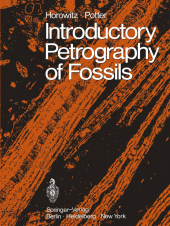 Neuerscheinungen 2011Stand: 2020-01-07 |
Schnellsuche
ISBN/Stichwort/Autor
|
Herderstraße 10
10625 Berlin
Tel.: 030 315 714 16
Fax 030 315 714 14
info@buchspektrum.de |

Alan S. Horowitz, Paul E. Potter, George R. Ringer
(Beteiligte)
Introductory Petrography of Fossils
Fotos: Ringer, George R.
2011. xvi, 302 S. XIV, 302 pp. 28 figs., 100 plates. 280 mm
Verlag/Jahr: SPRINGER, BERLIN 2011
ISBN: 3-642-65113-5 (3642651135)
Neue ISBN: 978-3-642-65113-7 (9783642651137)
Preis und Lieferzeit: Bitte klicken
This is a book for beginners. Not geological beginners, because an introductory course in paleontology and some knowledge of the petrographic microscope is assumed, but for beginners in the study of the petrography of fossil constituents in sedimentary rocks. Fossils are studied for various reasons: 1) to provide chron ologic (time) frameworks, 2) to delineate rock units and ancient environments, or 3) to understand the past development (evolu tion) of living plants and animals. All of these uses may be at tained through petrographic studies of thin sections of fossils embedded in sedimentary rocks. Some knowledge of the appear ance of fossils in thin section is also fundamental for general stratigraphic studies, biofacies analyses, and is even useful in studying some metamorphic rocks. Commonly, fossils are essen tial for the delineation of carbonate rock types (facies or bio facies). We have written this book for sedimentary petrologists and stratigraphers, who routinely encounter fossils as part of their studies but who are not specialists in paleontology, and for students who are seeking a brief review and an introduction to the literature of the petrography of fossiliferous sedimentary rocks. Although experienced paleontologists may be appalled by the many generalized statements on size, shape, and principal fossil characters recited herein, we counter that we have had some success in introducing non-paleontologically oriented geologists to the use and identification of fossil constituents without using excessive paleontological terminology and detailed systematics.
1Introduction.- References Cited.- 2 Getting Started in Carbonate Petrography: Methodology and Applications.- Essential Elements of Carbonate Petrography Classification.- Mapping and the Fundamental Characteristics of Carbonate Bodies.- Models and Cycles.- How Carbonate Petrology Started.- Selected Chronologie, Annotated References.- References Cited.- 3 Identification of Biotic Constituents.- Geometry of Skeletal Architecture.- General Observations on Skeletal Microstructure.- Skeletal Mineralogy.- Post-Mortem Changes in Shells and Shell Microstructure.- Tintinnines.- Radiolarians.- Foraminifers.- Sponges (Porifera).- Archaeocyathids.- Corals (Anthozoan Coelenterates).- Stromatoporoids.- Bryozoans.- Brachiopods.- Worms.- Mollusks.- Molluscan Skeletal Architecture.- Molluscan Skeletal Microstructure.- Pelecypods.- Gastropods.- Cephalopods.- Arthropods.- Trilobites.- Ostracodes.- Echinoderms.- Conodonts.- Vertebrates.- Faecal Pellets.- Wood.- Calcareous Algae.- Red Algae (Rhodophyta).- Green Algae (Chlorophyta).- Blue-Green Algae (Cyanophyta).- A Problematic Alga.- Calcispheres.- Some Additional Fossil Groups Not Discussed.- Microfacies References.- References Cited.- 4 Plates.- References Cited.- Plate Titles.- Plates and Plate Descriptions.- Index to Plates.


